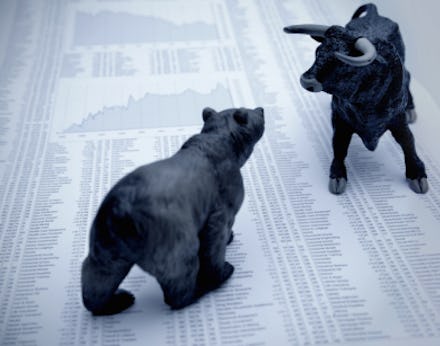2014 May Finally Bring the Market Correction Some Experts Are Freaking Out About

Update: The title of this article has changed from its orginal published version.
As this bull market ended 2013 with a roar, some economists and research groups are already bracing for a major correction in 2014 that could be anywhere from 10% to 20%.
Unlike previous historic highs, this bull market is almost entirely because of the Fed’s quantitative easing efforts (printing money out of thin air) and purchasing $85 billion a month (over $1 trillion total in 2013), divided between $40 billion of mortgage bonds and $45 billion in Treasury securities. In other words, all that money pumping has been going straight to the banks and very little of it is being lent out. Unless the banks lend those deposits, or invest them, they don’t get into the economy, they don’t enter the money supply, and they don’t contribute to inflation. But if banks aren’t lending, there’s no boost to the economy either – which is probably why most Americans aren’t feeling this “recovery.”
The Fed announced in December that it would be tapering down its buy back efforts from $85 billion to $75 billion a month. Some economists are predicting that it may be a signal that banks will start lending again, inevitably causing huge inflation in the wake of printing all that new money. Once those funds pass through the reserves and hit the markets, the fear then is that inflation will surge.
While GDP growth for Q3 hit an unexpected 4.1% primarily driven by strong consumer spending, history shows that’s not enough to bank on consistent market growth.
“We’ve looked at all the bear markets since 1956 and found seven associated with an inverted yield curve (in which short-term interest rates are higher than long ones) – a classic sign of Fed tightening,” explains Ned Davis Research in a recent interview with Barron’s. “Those declines lasted well over a year and took the market down 34%, on average.”
“We also looked at midterm-election years – the second year of a presidential term, like the one coming up in 2014 – going back to 1934, and the average decline in those years was 21%,” said Ned Davis Research.
Global Financial’s chief investment officer, Chris Bertelsen, is also predicting a 10% to 12% market correction in 2014. “This has been one of the most hated bull markets in a while because people can’t believe that it’s continuing to go up,” says Bertelsen. “Who’s left to buy? There’s just nobody left to buy. … Some event is going to set people off and when it does, plenty of investors will be hitting the register.”
But the real question after that then becomes how bad will the ripple effects in an already weak job market become?
While the official unemployment rate dropped to 7% at the end of 2013 – primarily due to more and more job seekers giving up looking for work and switching to food stamps, Medicaid, and disability (all still at historic highs) – the real unemployment rate remains at 11.5% when you include those on welfare as well. Additionally, most of the job creation since the recession has been in part-time employment – which hit a new record high in 2013. In fact, Kelly Services – a temp agency – closed out 2013 as the second largest employer in the U.S., behind only Walmart.
The reasons for this are numerous. To businesses, the benefits associated with employing part-time workers are countless: avoiding substantial benefits-related costs, evading long-term job contracts, hourly basis wages, etc. In fact, as long as the Obama administration’s aggressive regulatory policies prevent strong economic growth (and they will for quite a while according to the non-partisan CBO, which concludes that any signs of strong economic growth aren’t visible for the remainder of this administration’s term and a weak job market is looking to be the new normal), employers will have even more leverage, while workers have less and are forced to agree to any employment terms, as long as they get some paycheck at all.